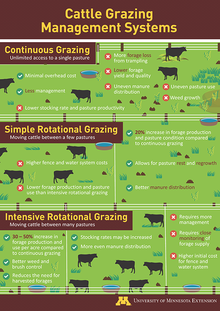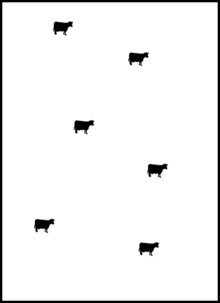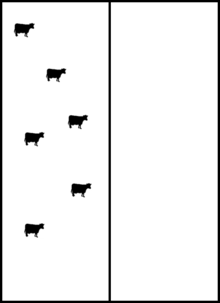Managed Grazing Systems and Fencing for Distribution of Beef Manure
Quick facts
- Producers use grazing to help reduce feed costs and make unproductive cropland productive.
- You should have a grazing plan to make sure you are as efficient as possible in using your grazing forage.
- The different grazing systems include continuous, simple rotational and intensive rotational.
- Rotational grazing is more productive than continuous grazing.
- Overgrazing results in decreased pasture quality and productivity.
- You should have a back-up plan for when things go wrong.
Benefits of grazing
Cost
The biggest cost in most, if not all, cattle production systems is feed. Many producers use grazing to reduce costs for their operations. Properly managed pasture-based systems use land efficiently and provide high production per acre.
Marginal land
Not all land can grow row crops. These pieces of land are usually described as marginal. Grazing is a way to grow a crop (grass) on land that is not suitable for traditional row crops such as corn and beans. Cows can use the grass and make otherwise unproductive land productive.
Environment
Grazing benefits the land itself. Studies have shown the benefit of grazing as a tool for conserving wildlife habitat and keeping prairie healthy.
Incorporating cover crops into a cropping system has major benefits to the land such as decreased compaction, decreased soil erosion, and decreased run-off. These cover crops can be used as a valuable part of a grazing rotation.
The importance of having a grazing plan
Designing a grazing plan is the first step in your pasture management system. As you follow the planning process, the strengths and weaknesses of your current system will become apparent.
The grazing plan should include all the components of the grazing and pasture system and serve as a map for making management improvements. The amount of grass available is limited and having a plan allows for the full use of the resources available.
Recording and tracking the success of your plan is important because you can then make improvements for the next grazing season.
Map your grazing
You should draw a map or use mapping software to show the boundaries of the land that is available for grazing. Having a map of your system makes it easier to get started on a plan and makes the plan easier to adjust for different conditions from year to year.
- Distinguish land that is owned from land that is rented. There are certain management practices that you can apply to your own land that you may not be able to do on rented land.
- Determine the number of acres of the different land parcels and label these on the map. You can then see what is available and what opportunities you have to improve or better use the resources you have.
- Mapping can show if there is additional land available that could be used for grazing.
- Cropland that is next to pasture land may be better used by growing forages.
- Cropland close to existing pastures is ideal for converting to grazing if pasture expansion is one of the farm goals.
Different grazing systems
Grazing systems range from continuous grazing of one area over a long period of time to intensive rotational grazing on small areas for short periods of time.
- Livestock systems that use continuous grazing of a pasture experience both overgrazing and under grazing of forages.
- A rotational system provides an opportunity for forage plants to rest so that they may regrow more quickly.
- The rotational system provides an opportunity to move livestock based on forage growth, promote better pasture forage utilization, and extend the grazing season.
The advantages and disadvantages of three grazing management systems are listed below.
Download the Cattle Grazing Management Systems poster.
|
A one-pasture system where livestock have unrestricted access throughout the grazing season.
Advantages
- Requires less management.
- Overhead costs are minimal (fence).
Disadvantages
- Lower forage quality and yields.
- Lower stocking rate and less forage produced per acre.
- Uneven pasture use.
- Greater forage losses due to trampling.
- Animal manure is distributed unevenly.
- Weed and other undesirable plants may be a problem.
A system with more than one pasture in which livestock are moved to allow for periods of grazing and rest for forages.
Advantages
- Can increase forage production and improve pasture condition (20% more compared to continuous).
- Allows pastures to rest and allows for forage regrowth.
- It can provide a longer grazing season, reducing the need for feeding harvested forages.
- Better distribution of manure throughout the pasture.
Disadvantages
- Costs for fencing and water systems can be higher than with continuous grazing.
- Forage production and pasture utilization are not as high as intensive rotational grazing systems.
A system with many pastures sometimes referred to as paddocks. Livestock are moved frequently from paddock to paddock based on forage growth and use.
Advantages
- Highest forage production and use per acre (30-50% more compared to continuous).
- Stocking rates can typically be increased.
- More even distribution of manure throughout the paddocks.
- Weeds and brush are usually controlled through grazing.
- It provides more grazing options and reduces the need for mechanically harvested forages.
Disadvantages
- Requires careful monitoring of forage supply.
- Initial costs may be higher due to fencing materials and water distribution systems.
- Requires more management.
Pasture quality and productivity
Good pasture condition is critical to a successful grazing system. Pasture quality may vary greatly from one pasture area to another, but the trend over time should show the direction in which the pasture condition is moving.
Forage grass and legume species each have their own unique growth, persistence, and quality characteristics. Because they respond differently to soil conditions, weather patterns, fertility and grazing management, the plants that are currently growing in your pastures may be different from one area to another.
Evaluating the entire system is important to the success of your plan.
Determining and measuring pasture quality
- First survey what is available. A walk through the pastures is necessary to gather this information.
- The overall coverage and density of forage in your pastures can be rated as thin, average, or thick.
- If the same people are evaluating the pastures every time, you can keep track of the trend.
- Identify dominant species in each pasture and use your map to keep track of what you find. If you need help identifying different species contact your local Extension office or your local USDA service center.
- For a relatively small cost, a forage sample you collect can be tested by your local forage lab. This information about protein, mineral content and more is incredibly valuable.
How to estimate pasture productivity (forage mass)
There are many methods for determining the productivity of a pasture. Several methods include the use of specialized equipment such as a rising plate meter, falling plate meter, infrared technology or even drones. The simplest methods are accurate and still provide important information. The unit used when determining pasture productivity is pounds of dry matter per acre (lbsDM/acre).
|
Hula-hoops are rigid, usually standard size and durable.
- Toss the hula-hoop into a representative section of your pasture.
- Where the hula-hoop lands, clip (close to the ground) all of the plants within the hula-hoop and gather them in a container.
- This sample can be weighed and dried to determine mass on a dry matter basis.
- The conversion to lbsDM/acre is made based on the area of the hula-hoop.
Using a square to sample a pasture is almost identical to the hula-hoop. Some people prefer a square to a circle. The process is the same.
- Using stakes and string or whatever method you decide, build a square in a representative portion of your pasture.
- Then clip (close to the ground) all of the plants within the square and gather them in a container.
- This sample can be weighed and dried to determine mass on a dry matter basis.
- The conversion to lbsDM/acre is made based on the area of the square.
Using a defined area and clipping a pasture is the most accurate method but can be time-intensive. Based on the density of the pasture we can use the height of the pasture to determine the approximate mass.
To do this, take a yardstick into the pasture, measure the height of the forage in 30 different locations and then calculate the average.
- Thin pasture: 150 lbsDM/acre per inch of height
- Average pasture: 300 lbsDM/acre per inch of height
- Thick pasture: 450 lbsDM/acre per inch of height
Stocking density - How many cows can a pasture hold and for how long?
Knowing the amount of dry matter forage a pasture can produce is only part of the equation. The amount of forage required over the grazing season by each animal and the herd as a whole is what determines stocking density.
The overall goal is to define the proper combination of land, time and number of animals to ensure the sustained, long-term productivity of the pasture. The optimum number of animals on the pasture makes efficient use of the forage without waste but still leaves enough forage to allow quick and complete plant recovery.
Understocking
- Setting the stocking rate too low will result in wasted forage and lost profit potential.
- Long term understocking (under grazing) can result in a less productive pasture as more woody plants take up residence.
Overstocking
- Setting the stocking rate too high for too long will result in lowered intake, lowered animal growth and diminished profits.
- Overstocking (overgrazing) leads to a reduction in desirable plant species and an increase in less desirable plants.
- Overuse also means that livestock must forage for longer periods of time to meet their needs and that results in decreased average daily gain (ADG).
|
In general, cows consume between 2 and 4 percent of their body weight in dry matter every day depending on their energy usage. We have to account for losses on the pasture due to trampling so the easiest way to do that is to lump everything into total use for each animal. In general, you can expect a cow to either eat or trample 4 percent of its body weight in dry matter each day.
How much forage does one cow use each day?
forage used/day/cow = (average body weight cow) × 0.04
Example: How much forage does a 1400-pound cow use each day?
1400lbs × 0.04 = 56 lbsDM/day
How much forage does the herd use each day?
daily herd forage requirement = (# of cows) × (forage used/day/cow)
Example: How much forage do ten 1400-pound cows use each day?
10 cows × 56 lbsDM/day = 560 lbsDM/day
If you know how much forage a pasture will produce and you know how much forage each cow in your herd will use each day, then deciding on stocking density is the next step.
Time is the all-important factor because the higher the stocking density the shorter time the pasture can be used. The inverse is also true, the longer the pasture is going to be used, the lower the stocking density must be to avoid overgrazing.
How many days can I use a pasture?
Days = (pounds of forage/acre) × (# of acres) / (daily herd forage requirement)
Example: How many days can I graze a 5-acre pasture producing 2500 lbsDM/acre with ten 1400-pound cows?
(2.500lbsDM) × (5 acres) / (560lbsDM/day)
How many cows can I put on my pasture?
# of cows =(pounds of forage/acre x # of acres) / (cow bodyweight lbs x 0.04 x days on pasture)
Example: How many 1400-pound cows can I put on a 5-acre pasture producing 2500 lbsDM/acre if I want to use the pasture for 40 days?
(2,500 lbsDM/acre) × (5 acres) / (1400 lbs) × (0.04) × (40 days)
Active management
Pasture management is an active process. If no effort or time is put into the system then the return will be minimal to the producer. Continually evaluating and adjusting with guidance from measurable data is the key to success.
|
Using the appropriate stocking density to avoid overgrazing and undergrazing while monitoring your pastures for the appropriate recovery time between animal use will keep your pastures in good condition. Sometimes, pastures need just a little more help, and there are several options.
Fertilizing
- Both nitrogen application and manure can be used to fertilize pasture.
- The timing of fertilization and which type you use can have a large impact on pasture quality and productivity.
- For more information on using manure as fertilizer visit the manure management web pages.
Interseeding
- Interseeding uses no-till drills to incorporate seed directly into the pasture.
- Proper preparation of the pasture is important for the success of this technique.
- Pastures should be grazed closely to give the new seedlings the least amount of competition when emerging.
Frost seeding
- Frost seeding is used to improve the density of current pastures.
- Seed is broadcast over the pasture during a time of year when there are many freeze/thaw cycles.
- The action of freeze and then thaw opens up the ground and allows seeds to be incorporated into the soil.
- Like interseeding, pastures should be grazed closely prior to implementing this technique.
Overgrazed pasture
- Starting a rotational grazing system when a continuous system was previously used will not provide instant results.
- Long term management and rotation will provide the base for good pasture to grow.
- Use techniques such as fertilization, interseeding and frost seeding to give the overgrazed pasture a kickstart.
Undergrazed pasture
- Get animals into the pasture to start using the grass.
- At first, use a high stocking density and allow the animals to graze the grass to near 100%.
- Follow with techniques like fertilizing, interseeding and frost seeding to start improving the pasture.
Complete pasture renovation
- This technique should only be used after other efforts have not worked, or you have consulted an expert on the specific pasture.
- Complete renovation involves using an herbicide to kill the existing plants in the pasture and then reseeding using no-till drills.
- Often the pasture kill is conducted in the fall and the pasture is seeded in the spring.
Not everything goes according to plan and that includes pasture management. The weather, livestock themselves, and other factors can put the perfect plan off course. You have to have a back-up plan.
Sacrificial pasture with bedding
You can choose a pasture you will use as your sacrifice pasture. Often, it is worth it to severely damage one pasture rather than damage all of your pastures. Keep your cows dry and out of the mud by putting bedding in the pasture.
Cattle holding area with concrete pad
Concrete can be a valuable and simple luxury. Mud is the enemy of all grazing systems and concrete can be the solution. Using bedding and supplementing feed on concrete is a valuable temporary technique for any grazing system.
Cattle holding building
The ultimate luxury for a grazing producer is a building you can use to confine your cattle when needed and keep them out of the elements while you give your pastures time.
Every pasture has areas that will be used by the cows more than others. High traffic areas such as walking lanes, watering areas, feed bunks, shade, wind breaks, and other stress areas should be identified and managed differently from other areas of your pasture.
The best solution is to pour concrete, if possible, to reduce the effect of mud in these areas. You can also use a temporary fence to allow certain areas a rest period from your animals.
Genetic choices for a grazing herd
Fertility
Whether it is dairy or beef, fertility is still the driver of profitability for any cattle grazing system. Producers should keep fertility as the main focus when selecting genetics for their herd.
Longevity
The length of time an animal remains profitable in a system maximizes the return on a producer's initial investment. The initial investment can be raising or buying a replacement. Either way, the longer the animal stays in your herd as a profitable member the better.
Feet and legs
Feet and legs are one of the main factors in the longevity of a cow in both grazing and confinement systems. Cattle on pasture walk more than cattle in confinement and the ability of cattle to move is incredibly important in order to eat grass on pasture. Solid feet and legs should keep a cow profitable in your system for a long time.
Supplementing a grazing herd
The decision to supplement cattle on pasture is determined by several factors.
- Current and future pasture availability are the most important factors. If cattle do not have access to adequate pasture then supplementation might be needed.
- If you know pasture will not be available in time for rotation, you can supplement to preserve the current pasture or delay the move.
- Using body condition scoring to determine ideal weights for your cows can give you insight on whether or not feed in addition to pasture is needed.
Reviewed in 2021
Source: https://extension.umn.edu/pasture-based-dairy/grazing-and-pasture-management-cattle




0 Response to "Managed Grazing Systems and Fencing for Distribution of Beef Manure"
Post a Comment